
If you wish this
program to be sent to your or your friends e-mail address,
please get a subscription (totally free of charge, and no
advertisements will be sent).
I would like to
get a subscription to
The Fourth Dimension in
Landscape Design>>>>>>>
I would
like to propose for my friend>>>>>>
|
Palm Centre Plant of the
Month DECEMBER
2011 |
|
 |
|
Imperata
genus of 6 species of perennials, found throughout
from East and South Asia to Australia. They are
belong to family of
Poaceae. They live at areas from tempate to tropical climate.
IMPERATA CYLINDRICA RUBRA
(RED BARON),
COGON GRASS OR JAPANESE BLOODGRASS
Imperata cylindrica rubra
is a species of
grass in the genus
Imperata. It is also called Bloody
Grass, because of the bright red color of the
leaves.
Japanese Bloodgrass
may reach to 50 cm high and 30 cm in diameter. Need
full sun to partial shade. It can withstand to -20˚C
degree, they prefer soils rich of organic material.
In cold areas, grass should be cut from soil level,
and covered with some mulching material at winter
time.
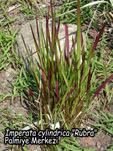 The
flowers of Imperata cylindrica
rubra
are not showy. They are silver coloured and seen on
long spikes at summer time.
Propagation can be done by dividing rhizomes at
spring.
Japanese Bloodgrass
normally seen red in upper 2/3 of
the leaves and green at the lower 1/3. Red-green
colour gives the plant an interesting and attractive
view. The
flowers of Imperata cylindrica
rubra
are not showy. They are silver coloured and seen on
long spikes at summer time.
Propagation can be done by dividing rhizomes at
spring.
Japanese Bloodgrass
normally seen red in upper 2/3 of
the leaves and green at the lower 1/3. Red-green
colour gives the plant an interesting and attractive
view.
In landscaping
Imperata cylindrica rubra
is useful in a mixed grass border.
If used with green, silver or blue coloured plants a
nice contrary effect obtained.
In landscaping they are often planted with
Carex morrowii variegata,
Festuca ovina glauca,
Stipa tenuissima,
Setaria palmefolia,
Scirpus cernuus
in beds.
Also can be used as a second plant row, in front of
long grasses like
Phormium, Penisetum, Miscanthus, Cortaderia,
Cymbopogon.
Japanese Bloodgrass
should be planted in groups for a sharper visual
effect. If it is used in containers, large circular
or rectangle shaped pots are preferred. Within pots
can be used in separation or to direct the public in
trade centers, pastry shops or restaurants. |
|
Palm Centre Plant of the
Month
NOVEMBER
2011 |
|
|
|
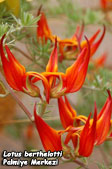 Lotus
genus of about 150 species of annuals, short_lived
perennials, or semi evergreen
subshrubs, found throughout most of the world. Some
are frost resistant, others are not. Lotus
genus of about 150 species of annuals, short_lived
perennials, or semi evergreen
subshrubs, found throughout most of the world. Some
are frost resistant, others are not.
Lotus berthelotii
is in the
genus
Lotus.
Parrot's beak,
a
perennial plant,
endemic to the
Canary Islands. This plant is either
extinct in the wild or persists as a few
individuals. Lotus berthelotii has a
creeping or trailing habit.
Leaves divided into 3-5 slender leaflets,
each leaflet 1-2 cm long and 1-2 mm broad, densely
covered with fine silvery hairs. The
flowers are orange-red with yellow
splashes, pea flower-shaped, 2-4 cm long and 5-8 mm
broad. Flowers all summer, peak flowering period is
end of the spring, and beginning of the summer. Although
Parrot's beak only grows to a height of
around 20 cm, the plant trails can be 60-80 cm wide.
 The
flowers of Lotus berthelotii and some other
Canary Island species appear to be adapted for
bird pollination. It was once thought
that the original
pollinators of these plants were
sunbirds which had become extinct on the
Canary Islands,
explaining why they are rare and considered
endangered species. However more recent work has
shown that these plants are adequately pollinated by
non-specialist flower visiting birds The
flowers of Lotus berthelotii and some other
Canary Island species appear to be adapted for
bird pollination. It was once thought
that the original
pollinators of these plants were
sunbirds which had become extinct on the
Canary Islands,
explaining why they are rare and considered
endangered species. However more recent work has
shown that these plants are adequately pollinated by
non-specialist flower visiting birds
 Parrot's
beak
is cultivated in the
horticulture trade and widely available
as an
ornamental plant with its needle-like
silvery foliage and red
flowers for traditional
gardens, container, and
drought tolerant water conserving
gardens.
It should be planted 50-60 cm apart when grown as
ground cover.
A golden orange flowering
cultivar is also grown. Parrot's
beak
is cultivated in the
horticulture trade and widely available
as an
ornamental plant with its needle-like
silvery foliage and red
flowers for traditional
gardens, container, and
drought tolerant water conserving
gardens.
It should be planted 50-60 cm apart when grown as
ground cover.
A golden orange flowering
cultivar is also grown. |
|
Palm Centre Plant of the
Month
OCTOBER
2011 |
|
|
|
Cestrum nocturnum
is a tender evergreen shrub, native to the
subtropical climates of Mexico, Central America, the
West Indies and Cuba. It is not a true Jasmine, but
is in fact a member of the same family as tomatoes
and peppers.
Night-blooming Jasmine
can quickly form a mound of foliage up to 23 meter
high, and 12 meter across. This plant has long,
slender, arching branches springing densely from the
base. All parts of the plant are poisonous, and its
fragrance can be overwhelming to some people,
especially
those with allergies.
Clusters of slender,
pale green-white flowers appear in late summer and
autumn, strongly and sweetly perfumed at night but
scentless during the day. The flowers are followed
by berries that are green at first but a glossy
china white when ripe in early winter.
Propagation Is from seed or from herbaceus stem
cuttings.
Cestrum nocturnum is sensitive to
frost, it only can stand -4˚C for a short period.
In landscape is useful
in a mixed shrub border. The fragrance is most
noticeable at night, intelligence gardeners
strategically place this plant where the scent can
be enjoyed in the evening. |
|
Palm Centre Plant of the
Month
SEPTEMBER
2011 |
|
|
|
Musella lasiocarpa
is a great plant for a tropical effect in
cooler climate zones. It is not a true
banana, but a banana relative, and has a
smaller, shrub-like form. It can produce a
large, lotus-shaped, waxy yellow flower that
will remain in bloom for six months.
Chinese Yellow Banana
comes from high altitudes (to a frosty 2800
m) in the Yunnan Province in China.
Botanists with a working knowledge of Yunnan
and Musella think that it may be extinct in
the wild and maintained only in cultivation
by farmers in Yunnan and Sichuan.
Its flower is known as the Golden Lotus
Flower, a sacred flower in local Buddhism.
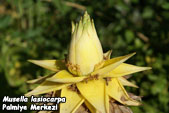 The maximum height of
the
Musella lasiocarpa is only about 1,5 m,
half of which is a very stout, conical trunk,
which is then topped by a crown of handsome,
slightly glaucous, broad leaves.
Leaves held rather stiffly upright, glaucous
green with reddish-brown margins.
From early age, the
rhizome of Chinese Yellow Banana
produces many suckers. The inflorescence,
which is big and bright yellow, appears in
its second or third year if it is grown from
seed. Flower grows upright at the top of the
trunk. As the inflorescence grows in size,
tiny bananas begin to appear under each
bract, which curls back to reveal the fruits.
Unfortunately inedible, the 5 cm long
bananas each contain dozens of small, shiny,
brown-black seeds. The maximum height of
the
Musella lasiocarpa is only about 1,5 m,
half of which is a very stout, conical trunk,
which is then topped by a crown of handsome,
slightly glaucous, broad leaves.
Leaves held rather stiffly upright, glaucous
green with reddish-brown margins.
From early age, the
rhizome of Chinese Yellow Banana
produces many suckers. The inflorescence,
which is big and bright yellow, appears in
its second or third year if it is grown from
seed. Flower grows upright at the top of the
trunk. As the inflorescence grows in size,
tiny bananas begin to appear under each
bract, which curls back to reveal the fruits.
Unfortunately inedible, the 5 cm long
bananas each contain dozens of small, shiny,
brown-black seeds.
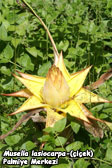 The seeds of
Musella lasiocarpa
requires cool stratification (about 4°C,
more than 6 weeks) but then germinates
easily, and subsequent seedling growth is,
as you might expect, very fast. Musella
appreciates heavy watering and feeding and a
place in full sun. It will flourish in all
climates from cool tropical down to
temperate, where it will be found to be root
hardy, enduring even cold winters with its
underground rhizome, just like well known
hardy bananas. It also makes a perfect
conservatory plant. The seeds of
Musella lasiocarpa
requires cool stratification (about 4°C,
more than 6 weeks) but then germinates
easily, and subsequent seedling growth is,
as you might expect, very fast. Musella
appreciates heavy watering and feeding and a
place in full sun. It will flourish in all
climates from cool tropical down to
temperate, where it will be found to be root
hardy, enduring even cold winters with its
underground rhizome, just like well known
hardy bananas. It also makes a perfect
conservatory plant.
In landscape,
may be used as an accent plant, or in front
of the long banana trees as a second line
shrub. Also can be used in groups. In cold
areas like as Ankara, plant should be kept
in a container, and not to leave outside at
winter.
|
|
|
Palm Centre Plant of the
Month AUGUST 2011 |
|
|
|
|

Clerodendrum bungei:
Rose Glory Bower, Mexican Hydrangea
Genus of about 400
species of deciduus and evergreen trees, shrubs, and
climbers, mainly found in woodland in tropical and
subtropical regions, particularly in Africa and Asia.
They are cultivated for their nice flowers. The
leaves are arranged in whorls or opposite pairs. The
shrubs are suitable for a warm border. Train the
climbers over a trellis, pergola or other support.
In frost-prone areas, grow half-hardy and frost-tender
species in a warm greenhouse or conservatory.
Rose Glory Bower is a
deciduous shrub that spreads aggressively by sending
up suckers all around itself. Clerodendrum
bungei is native to China and northern India
The invasive nature of Rose Glory Bower has
allowed it to become established in numerous areas
throughout South America, Mexico, Florida and other
southern states of USA.
The upright,
minimally branched, shoots can get 100120 cm tall
and sometimes they can reach a height of 200 cm.
Oval shaped leaves, to 20 cm long, with long
petioles and coarse marginal teeth. The leaves have
a strong unpleasant smell. The rose colored flowers
are in rounded clusters 20 cm across and carried
above the leaves. Individual flowers are funnel
shaped with five spreading petal-like lobes. The
flowers are very fragrant and last from summer until
first frost. In winter, the upright stems, mostly
devoid of branches, are not very attractive and may
appear to be dead.
Propagation:
Propagation of glory bower is easy. Tip cuttings
root readily. Suckers can be dug up and repositioned.
Pieces of root can be dug up and replanted. Or you
can just wait a few weeks and it will probably
propagate itself all over the place.
 Usage in Landscapes Usage in Landscapes
Use Rose Glory Bower in well defined areas,
otherwise it will surely spread. As withstands -10˚C
cold, can be used at any town at coastal areas in
Turkiye. Also it can be kept in containers. Once
incarcerated, Clerodendrum bungei is a
beautiful landscape flower and one that attracts
butterflies.
|
|
Palm Centre Plant of the
Month JULY
2011 |
|
|
|
Polygala is
a genus which covers more than 500 species, all
around the world. Polygala is an old Greek
name from the words polys meaning much and gala
meaning milk, the name given to this genus for some
of its members which have the reputation for
promoting the secretion of milk at human and some
mammals. They include annuals, perennials and some
shrubs. Two biggest sepal of pea like flowers are
rose purple, petal like and known as wings. The keel
terminates in crown like tuft that is
characteristic of polygalas. They need light,
well drained soil in a sunny or part shaded spot.
They are suitable for pot culture. To keep the growt
dence, prune any straggly stems after the main
flowering has finished.
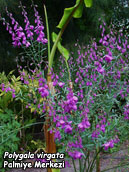 Polygala virgata is one of the
beautiful species belonging to the Polygalaceae
family also
commonly known as
the milkwort family. This charming slender shrub,
bearing spikes of bright purple magenta winged
flowers is an eye-catcher in any garden. It has a
wide distribution and occurs both in Tropical and
East Africa, southwards through Natal, Transvaal,
into the Cape as far as George. Growing in the
Drakensberg it is found at an altitude of 250 to
1800 m. Polygala virgata is one of the
beautiful species belonging to the Polygalaceae
family also
commonly known as
the milkwort family. This charming slender shrub,
bearing spikes of bright purple magenta winged
flowers is an eye-catcher in any garden. It has a
wide distribution and occurs both in Tropical and
East Africa, southwards through Natal, Transvaal,
into the Cape as far as George. Growing in the
Drakensberg it is found at an altitude of 250 to
1800 m.
Purple Broom
is an erect, evergreen shrub and grows to a height
of 2,0 to 2,5 m. A single stem is formed at the base
of the plant and slender hairless branches occur at
the top. The leaves are narrow in shape, dark green
with a velvety texture and 10 mm in length. Simple
leaves are alternately arranged on younger branches
and usually drops before flowering. Racemes of deep
purple magenta flowers are borne at the ends of
branches. The flowers look similar to that of a pea
family Fabaceae, but are different. The flower is
enclosed by 2 large purple bonnet-like bracts and
streaked with darker veins. These open to show that
the flower has a purple tuft of tiny hairs at the
top of the lower keeled petal. The outer two petals
surround the lowest petal like a bonnet. The fruit
is a two-celled capsule and the seed is small, black
and oval shaped.
Polygala virgata is a fast growing,
hardy shrub and can be grown in any garden in
Mediterrenean climate. Once established in the
garden will tolerate drought, wind and some frost.
With its beautiful sprays of flowers it will be an
accent plant in a shrubby garden or rockery. Planted
in good enriched soil in a sunny or semi-shade
position in the garden. It requires water once
established to encourage rapid and healthy growth.
The shrub is a buzz with bees, insects and
bumblebees attracted to the bright purple magenta
flowers.
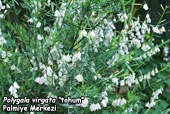 Purple
Broom
is a fast growing, hardy shrub and can be grown in
any garden in South Africa or in Mediterrenean
climate countries. Once established in the garden
will tolerate drought, wind and some frost. With its
beautiful sprays of flowers it will be an accent
plant in a shrubby garden or rockery. Planted in
good enriched soil in a sunny or semi-shade position
in the garden. It requires water once established to
encourage rapid and healthy growth. Purple
Broom
is a fast growing, hardy shrub and can be grown in
any garden in South Africa or in Mediterrenean
climate countries. Once established in the garden
will tolerate drought, wind and some frost. With its
beautiful sprays of flowers it will be an accent
plant in a shrubby garden or rockery. Planted in
good enriched soil in a sunny or semi-shade position
in the garden. It requires water once established to
encourage rapid and healthy growth.
The Polygala virgata is self-seeding
and small seedlings appear around the parent plant
after the first flowering season. These seedlings
can be transplanted easily. Individual plants are
fairly short-lived, but can be easily replaced with
seedlings. Purple Broom is easily grown from
seed during autumn to spring. |
|
Palm Centre Plant of the
Month JUNE
2011 |
|
|
|
Polygala
is a genus which covers more than 500 species, all
around the world. Polygala
is an old Greek name from the words polys
meaning much and gala meaning milk, the name
given to this genus for some of its members which
have the reputation for promoting the secretion of
milk at human and some mammals. They include annuals,
perennials and some shrubs. Two biggest sepal of pea
like flowers are rose purple, petal like and known
as wings. The keel terminates in crown like tuft
that is characteristic of polygalas. They need light,
well drained soil in a sunny or part shaded spot.
They are suitable for pot culture. To keep the growt
dence, prune any straggly stems after the main
flowering has finished.
 Myrtle-leaf
milkworth
is a common, widespread pioneer shrub with pretty
mauve flowers on and off throughout the year with a
peak in spring. The species name myrtifolia
means myrtle-like leaves. Polygala myrtifolia
varies in form as it changes to adapt to the
different areas it grows in, from the harshness of
the coast to the drier inland climates. An evergreen
shrub, reach about 1,52,0 m in height with a few
upright-growing stems and slender branches densely
covered with leaves that resemble myrtle. The oval-shaped
leaves are usually 2550 mm long and up to 13 mm
wide. The leaves are light green, dark green or
slightly grey. Some forms of P. myrtifolia
have thin, needle-like leaves. It can also grow into
a small tree reaching almost 4 m high. Myrtle-leaf
milkworth
is a common, widespread pioneer shrub with pretty
mauve flowers on and off throughout the year with a
peak in spring. The species name myrtifolia
means myrtle-like leaves. Polygala myrtifolia
varies in form as it changes to adapt to the
different areas it grows in, from the harshness of
the coast to the drier inland climates. An evergreen
shrub, reach about 1,52,0 m in height with a few
upright-growing stems and slender branches densely
covered with leaves that resemble myrtle. The oval-shaped
leaves are usually 2550 mm long and up to 13 mm
wide. The leaves are light green, dark green or
slightly grey. Some forms of P. myrtifolia
have thin, needle-like leaves. It can also grow into
a small tree reaching almost 4 m high.
The buds are green, flat, marked with dark veins and
oval to half-moon-shaped. The lower buds open first.
The flowers are carried in small clusters at the
ends of short branches and look a bit like legume (pea)
flowers, but are actually quite different. Close
inspection will reveal that although they have two
wings and a keel, they lack the banner (also called
standard) petal. The showy petals, beautifully
marked with darker veins, are usually in shades of
mauve or purple, but can also be pink scarlet, or
white. Polygala myrtifolia has
blooms throughout the year with a peak in spring
when the plants flower profusely. The fruit is a
small, winged capsule.
Myrtle-leaf milkworth
can easily be propagated from seed and tip cuttings
preferably taken in spring and autumn
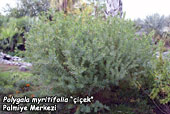 Use
in landscape: Myrtle-leaf milkworth
is an attractive
evergreen shrub able to adapt to most gardens and
gardeners. A tough shrub suitable for coastal
gardens, low maintenance and water-wise gardens. In
the new garden it is excellent as a fast growing
windbreak, hedge and colourful shrub able to grow in
most soil types from full sun to semi-shade. Its
growth is a bit more lax, producing fewer flowers in
the shade. As mentioned, there are different forms
of Polygala myrtifolia. At
Kirstenbosch a beautiful, white-flowering form
called P. myrtifolia 'White Feathers'
have been selected. Polygala myritifolia bibi
pink is a small variety which is suitable o
use as a container plant. Use
in landscape: Myrtle-leaf milkworth
is an attractive
evergreen shrub able to adapt to most gardens and
gardeners. A tough shrub suitable for coastal
gardens, low maintenance and water-wise gardens. In
the new garden it is excellent as a fast growing
windbreak, hedge and colourful shrub able to grow in
most soil types from full sun to semi-shade. Its
growth is a bit more lax, producing fewer flowers in
the shade. As mentioned, there are different forms
of Polygala myrtifolia. At
Kirstenbosch a beautiful, white-flowering form
called P. myrtifolia 'White Feathers'
have been selected. Polygala myritifolia bibi
pink is a small variety which is suitable o
use as a container plant. |
|
Palm Centre Plant of the
Month APRİL
2011 |
|
|
|
Pontederia
is a genus of five species found growing in the wild
on the margins of freshwater streams and ponds in
North, Central and South America. The name
Pontederia derives from Guilio Pontedero who was a
student at Padua University in the 17th century. The
plant is grown for its striking leaves and beautiful
flowers, which are usually blue but can also be
white.
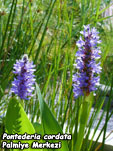 Pontederia
cordata
would seem to have obtained the cordata in its
name from the heart shape of the bases of its leaves.
Pontederia is grown from Nova Scotia in
Canada down to Florida as a marginal plant in water
features, or as a bog plant. It does not have a
central trunk but each leaf appears on its own long
stem. The dark green shiny leaves are lance-like
then widen out in the middle to form a heart shaped
top. In summer and early autumn flower stems produce
masses of blue flowers. Pontederia
cordata
would seem to have obtained the cordata in its
name from the heart shape of the bases of its leaves.
Pontederia is grown from Nova Scotia in
Canada down to Florida as a marginal plant in water
features, or as a bog plant. It does not have a
central trunk but each leaf appears on its own long
stem. The dark green shiny leaves are lance-like
then widen out in the middle to form a heart shaped
top. In summer and early autumn flower stems produce
masses of blue flowers.
Pontederia cordata
is extremely frost hardy and grows in 20 25cm
depth of water. It reaches a height of 1 1.5m, and
one plant will multiply and spread to a breadth of
around 1m. Pontederia cordata alba
is the white flowering plant which, apart from the
flower colour, is identical to its purple
counterpart in all aspects of development.
Propagation is from seed or from splitting
established plants in the spring.
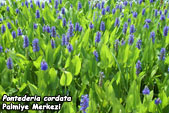 In
landscaping this plant with its shiny, dark green
leaves and lovely long stemmed blue flowers, is a
plant of choice for any water feature or bog garden.
Pontederia, is cheap and easy to grow,
withstands frost and other abnormal conditions and
thrives in water up to 25cm in depth. All of this
makes it a guaranteed success when used as a
marginal water or bog plant. In
landscaping this plant with its shiny, dark green
leaves and lovely long stemmed blue flowers, is a
plant of choice for any water feature or bog garden.
Pontederia, is cheap and easy to grow,
withstands frost and other abnormal conditions and
thrives in water up to 25cm in depth. All of this
makes it a guaranteed success when used as a
marginal water or bog plant.
|
|
Palm Centre Plant of the
Month APRİL
2011 |
|
|
|
Euphorbias
are members of one of the largest plant families:
the Euphorbiaceae. This family contains 300 species
and around 7,500 varieties. The Euphorbia
species alone includes about 2000 varieties: annuals,
biennials, perennials, grasses, shrubs and trees.
Some of these have succulent type leaves, some are
deciduous, others evergreen; some are extremely
hardy whilst others are tropical and very tender.
In fact the most interesting thing about
Euphorbias is the amazing range of plant forms
they display, especially in terms of size;
conditions in which they grow: tolerance for heat
and water needs; and the varying lengths of time for
which any individual plant can live. Most
euphorbias contain a milky liquid but sometimes
this can be colourless.
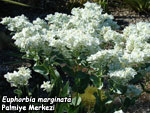 Euphorbia
marginata,
or Snow-On-The-Mountain, is an erect annual
native from Minnesota to Colorado and Texas. The
light green leaves are ovate to oblong, 1 3 inches
(2,5 7,5cm) long. With broad variegated margins,
the plants are conspicuous in the landscape, usually
between 2 4 feet in height with a single stem. The
latex they contain is corrosive to the skin and may
cause severe burns or dermatitis. As with all
members of the Euphorbiaceae, plant parts should be
handled with care, especially when sap is showing. Euphorbia
marginata,
or Snow-On-The-Mountain, is an erect annual
native from Minnesota to Colorado and Texas. The
light green leaves are ovate to oblong, 1 3 inches
(2,5 7,5cm) long. With broad variegated margins,
the plants are conspicuous in the landscape, usually
between 2 4 feet in height with a single stem. The
latex they contain is corrosive to the skin and may
cause severe burns or dermatitis. As with all
members of the Euphorbiaceae, plant parts should be
handled with care, especially when sap is showing.
Plants flower in early autumn; the flowers (actually
inflorescences and their showy bracts) form small
white cups, known as cyathia, at the top and center
of the plant. White and green bracts provide the
colouring. Snow-On-The-Mountain makes a long lasting
cut flower if the cut end is seared or dipped in
boiling water.
Euphorbia marginata
need full sun to partial shade, with a well-drained
soil mix. They are not particular about the soil.
The plants should be well watered and be allowed to
dry before watering again. The plants are native to
poor soils and do not need fertilizer or excessive
water. Too much water or fertilizer will provide
lush growth but at the expense of flowers.
Euphorbia marginata are propagated
from seed. Seed should be sown where you want the
plants to grow.
Snow-On-The-Mountain
when used in landscaping they are often planted with
dahlias, mums and other autumn flowering plants.
Whether grown in containers or in beds in the garden,
they are very showy. |
|
Palm Centre Plant of the
Month MARCH
2011 |
|
|
|
Ricinus belong to Euphorbiaceae
family. Ricinus communis is the only
member of the species. Castor Bean plants are
native to northeastern Africa and west Asia. Bean
seeds have been found in Egyptian tombs dating back
thousands of years.
Ricinus communis
is very fast growing, mound forming, suckering,
monoecious, evergreen shrub, widely naturalized in
wasteland, at roadsides. Castor Oil Plant
grows up to 10 m tall. In its first year, it grows
to 1-5m tall and perishes during autumn frosts.
It is grown throughout the world as an annual plant
or evergreen shrub or tree in tropical climates.The
root system consists of a well-developed taproot
that reaches depth of 34 m.
Castor Oil Plant
erect, branching shrub, with alternate, very
broadly ovate deeply 5 to 12 lobed, toothed, glossy,
midgreen, reddish purple, or bronze-red leaves
15-40cm long.
Inflorescences are racemes 6080 cm long, located on
the ends of branches. Male flowers occupy lower part
of the raceme; female flowers occupy the upper part;
all are apetalous. Fruits are spherical or oblong
pods, 23 cm across, usually with prickles, three-celled,
with 1 seed in each cell. Seeds are 820 mm across,
oval, gray to dark red with gray or other color
mosaic.
Ricinus communis
is a thermophilic
plant, suffers from frosts. Shoots perish at
temperatures below -1°C; adult plants die at
temperatures below -3°C. Temperatures should not
fall below 2025°C to ensure normal plant
development. It withstands some drought. Vegetative
period (from shoot emergence to maturing of first
raceme) lasts 100150 days.
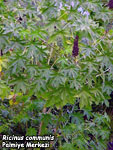 Castor Oil Plant
has several widely known uses, grown as a rodent
repellent, or grown for its derivatives, the toxin
known as Ricin and the dreaded castor oil. The beans
are most definitely toxic to humans and animals.
Care should be taken when handling them, don't allow
young children or pets in their vicinity without
close supervision. The principal toxin is an albumin,
called ricin. The seeds contain 2,83% toxic
substances, 320 seed killing a man, 4 a rabbit, 5 a
sheep, 6 an ox or a horse, 7 a pig, 11 a dog, but
80 for cocks and ducks. However, the effectiveness
of this plant at poisoning or driving out moles,
gophers or other tunneling animals is probably more
hype than fact. Castor Oil Plant
has several widely known uses, grown as a rodent
repellent, or grown for its derivatives, the toxin
known as Ricin and the dreaded castor oil. The beans
are most definitely toxic to humans and animals.
Care should be taken when handling them, don't allow
young children or pets in their vicinity without
close supervision. The principal toxin is an albumin,
called ricin. The seeds contain 2,83% toxic
substances, 320 seed killing a man, 4 a rabbit, 5 a
sheep, 6 an ox or a horse, 7 a pig, 11 a dog, but
80 for cocks and ducks. However, the effectiveness
of this plant at poisoning or driving out moles,
gophers or other tunneling animals is probably more
hype than fact.
However, it produces
immunizing activity, producing in small doses an
antitoxin analagous to that produced against
bacteria.
Castor beans are pressed to extract castor oil which
is used for medicinal purposes. Ricin does not
partition into the oil because it is water-soluble,
therefore, castor oil does not contain ricin.
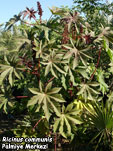 Castorbean is cultivated
for the seeds which yield a fast-drying, non-yellowing
oil, used mainly in industry and medicines. Oil used
in coating fabrics and other protective coverings,
in the manufacture of high-grade lubricants,
transparent typewriter and printing inks, in textile
dyeing. Dehydrated oil is an excellent drying agent
which compares favorably with tung oil and is used
in paints and varnishes. Hydrogenated oil is
utilized in the manufacture of waxes, polishes,
carbon paper, candles and crayons. 'Blown Oil' is
used for grinding lacquer paste colors, and when
hydrogenated and sulfonated used for preparation of
ointments. Castor Oil Pomace, the residue after
crushing, is used as a high-nitrogen fertilizer.
Although it is highly toxic due to the ricin, a
method of detoxicating the meal has now been found,
so that it can safely be fed to livestock. Castorbean is cultivated
for the seeds which yield a fast-drying, non-yellowing
oil, used mainly in industry and medicines. Oil used
in coating fabrics and other protective coverings,
in the manufacture of high-grade lubricants,
transparent typewriter and printing inks, in textile
dyeing. Dehydrated oil is an excellent drying agent
which compares favorably with tung oil and is used
in paints and varnishes. Hydrogenated oil is
utilized in the manufacture of waxes, polishes,
carbon paper, candles and crayons. 'Blown Oil' is
used for grinding lacquer paste colors, and when
hydrogenated and sulfonated used for preparation of
ointments. Castor Oil Pomace, the residue after
crushing, is used as a high-nitrogen fertilizer.
Although it is highly toxic due to the ricin, a
method of detoxicating the meal has now been found,
so that it can safely be fed to livestock.
Many varieties have been
cultivated and 'Carmencita' is one of the most
attractive with bold foliage and bright red flowers. |
|
Palm Centre Plant of the
Month FEBRUARY
2011 |
|
|
Neomarica
is a genus of 16 species of plants in family
Iridaceae, native to tropical regions of western
Africa, and Central and South America. The genus
name is derived from the Greek words neo, meaning
"new", and Marica, the Roman nymph.
Walking iris has evergreen foliage. The foliage is
similar to that of an iris and flowers may be white,
yellow or blue. After flowering, the flower spikes
lean to the ground and develop plantlets at the end,
allowing the plant to quickly colonize a small area.
Neomarica Gracilis
- Walking Iris
Neomarica gracilis
is from Mexico and Costa Rica south to Brazil. This
species is sometimes called the "Walking Iris"
but this name may also be used for some of the other
species.
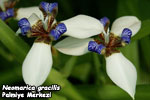 Neomarica
gracilis
is a herbaceous plant with leaves about one foot
tall. Flower spikes stand above the foliage. It has
short lived ivory flowers with reddish-brown
transverse bars on the claw. The inner segments are
smaller with reflexed tips and blue. It blooms in
late spring and early summer and appreciates shade.
After pollination, the new plantlet appears where
the flower emerged and the stalk continues to grow
longer. The weight of the growing plantlet causes
the stalk to bend toward the ground, allowing the
new plantlet to root away from its parent. This is
how it obtained the common name of "Walking Iris".
The other common name "Apostle Plant" comes
from the belief that the plant will not flower until
the individual has at least 12 leaves, the number of
apostles of Jesus. Neomarica
gracilis
is a herbaceous plant with leaves about one foot
tall. Flower spikes stand above the foliage. It has
short lived ivory flowers with reddish-brown
transverse bars on the claw. The inner segments are
smaller with reflexed tips and blue. It blooms in
late spring and early summer and appreciates shade.
After pollination, the new plantlet appears where
the flower emerged and the stalk continues to grow
longer. The weight of the growing plantlet causes
the stalk to bend toward the ground, allowing the
new plantlet to root away from its parent. This is
how it obtained the common name of "Walking Iris".
The other common name "Apostle Plant" comes
from the belief that the plant will not flower until
the individual has at least 12 leaves, the number of
apostles of Jesus.
It has leaves with
prominent veins and a stem that is forked below the
apex. It is distinguished from other white flowered
species, bearing its flowers on long (gracile)
peduncles.
The flowers emerge from what appears to be just
another leaf, but is really a flower stalk
structured to look like the other leaves.
They grow in shade in
subtropical areas in the wild. They come from
regions where the soils are extremely well drained (they
can also be found in a thick layer of forest debris).
Such soils are red, acid, high in iron and aluminum
and notoriously low in "normal" nutrients like
nitrogen, phosphorous, potassium, etc.
This is not a water Iris, be careful
not to overwater.
 Propagation
can be done by dividing rhizomes or offsets. Propagation
can be done by dividing rhizomes or offsets.
Neomarica gracilis
is not known in Türkiye also not commonly seen in
other countries. But it is a great pass-along plant,
a special group of plants that persist in our homes
and gardens because they are tough, easily
propagated and interesting enough to merit care.
The delicate flowers last only a day but the plant
continues to form new blooms for long periods of
time during late spring months. Makes also an
excellent houseplant.
|
|
Palm Centre Plant of the
Month JANUARY
2011 |
|
 Odontonema
strictum
is belong to
Acanthaceae family.
Firespike
is native to
open, semi-forested areas in
Central America.
It has escaped
cultivation and become established in disturbed hammocks
in several areas in peninsular of Florida. Odontonema
strictum
is belong to
Acanthaceae family.
Firespike
is native to
open, semi-forested areas in
Central America.
It has escaped
cultivation and become established in disturbed hammocks
in several areas in peninsular of Florida.
Odontonema strictum
is a showy,
attractive, compact
evergreen shrub with
sparse,
stiff branches that grow mostly straight up to about
150-200cm tall. It has shiny dark green leaves with wavy
margins and long pointed tips. The leaves are oblong,
arranged opposite each other on the stem, and 1015 cm
long. From autum through winter firespike produces
abundant 2030cm upright panicles of brilliant red
tubular flowers. The individual flowers are about 2cm
long and two-lipped.
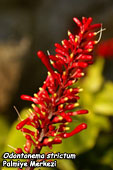 Firespike
do best if planted in partial shade with a rich well-drained
soil but also does well in full sun. Once
established it can tolerate all but the longest droughts.
Established plants should be watered even if it hasn't
rained for more than two or three weeks. Firespike
do best if planted in partial shade with a rich well-drained
soil but also does well in full sun. Once
established it can tolerate all but the longest droughts.
Established plants should be watered even if it hasn't
rained for more than two or three weeks.
In frost-free areas
Odontonema strictum
grows as an evergreen semi-woody shrub. In zones 8 and 9
it usually dies back to the ground in winter and
resprouts in spring.
Propagation: Softwood cuttings are very easy to root,
and they will bloom in their first year.
Use in landscape:
The strikingly beautiful crimson flowers and shiny
leaves of firespike brighten the fall landscape. Plant
firespike in mixed shrub borders. It will spread by
underground sprouting, enlarging to form a thicket, but
it is easy to control and keep contained. Firespike is a
must-have for subtropical and hot temparete butterfly
and hummingbird gardens. |
|

